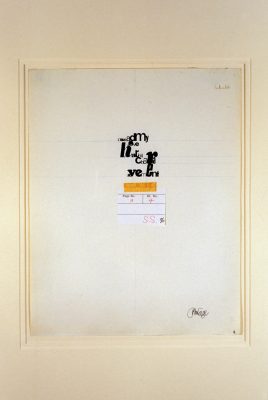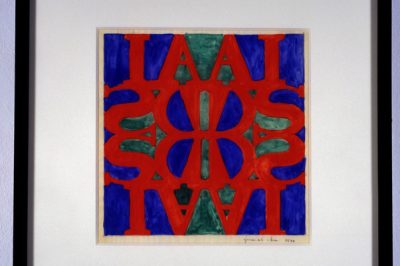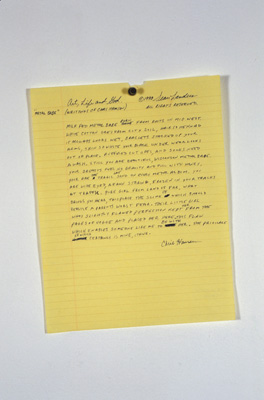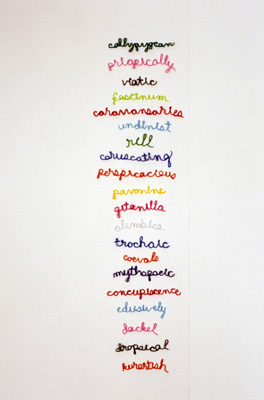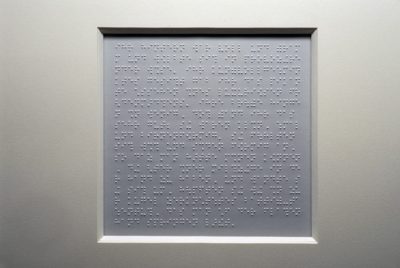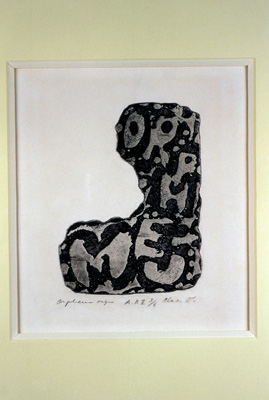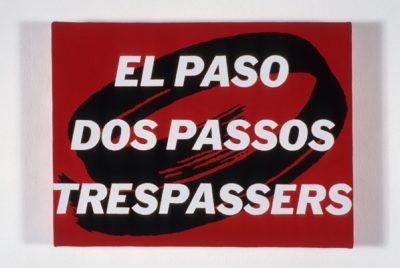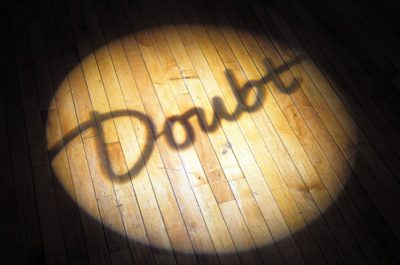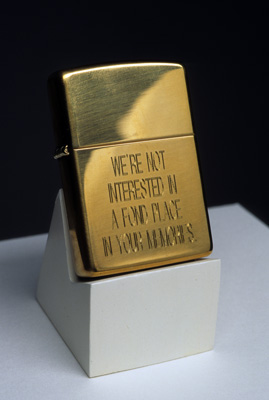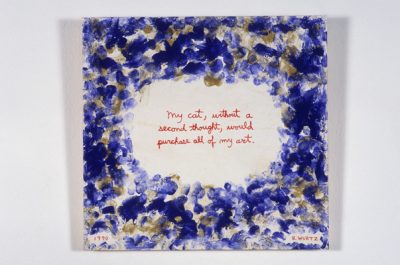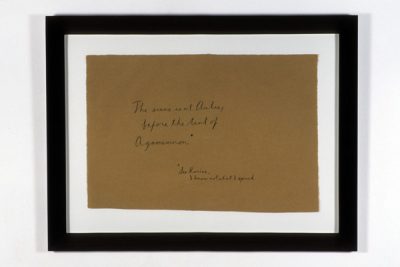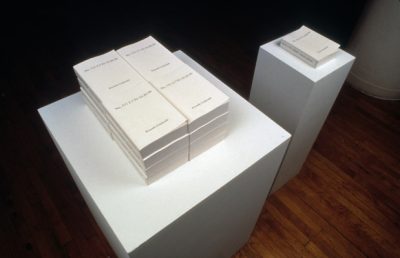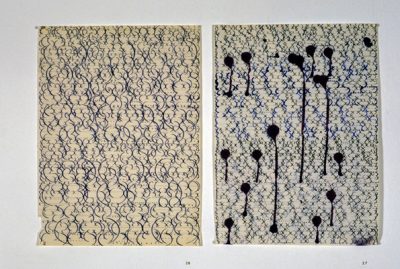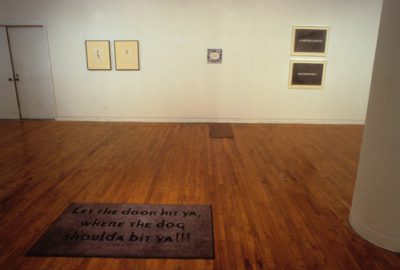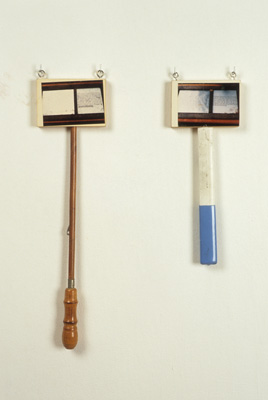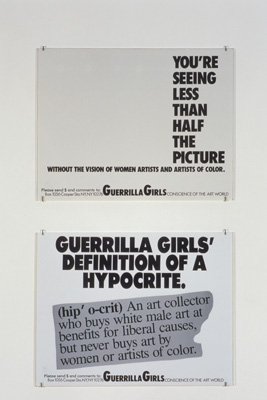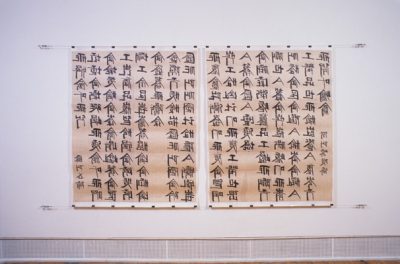Exhibitions
ABOUT THE EXHIBITION
Word Perfect was an exhibition that could have been taken for its words alone, as there were no images – in the standard sense of the word. The medium of the works is language. The nature of the visual experience in text-based work is different from image-based work, and the artists in Word Perfect chose language for its referential and functional precision. The concept of language as a visual phenomenon has played an important role in many of the aesthetic movements of the 20th Century; artists like Sean Landers summarizes prior events, while Lawrence Weiner uses equations. To some artists, text is enigmatic, leaving the viewer to fill in the blanks, while others use language for its narrative, semantic, or syntactical application. Whatever their linguistic format, their words are their material.
Some of the artists’ work in this exhibit employs an analytical approach to language, investigating vernacular idioms, preexisting signifying systems, and familiar decorative schemata. These word systems are manipulated through patterning, printing, stenciling, chance procedures, and repetition. Other works in the show aggressively elude contextualization because of their isolated linguistic formulations. And finally, some work simply refuses to deliver a message, making meaning dependent on the spectator’s psychological and cultural associations. Overall, these text works provide fewer supports on which to base one’s interpretation, opening up alternative ways for the viewer to assess meaning.
ARTISTS
Phil Berkman, Alighiero Boetti, Adam Brooks, William Burroughs, John Cage, Nancy Dwyer, Tom Friedman, General Idea, Kenneth Goldsmith, Felix Gonzalez-Torres, Guerilla Girls, Jenny Holzer, Sean Landers, Lou Mallozzi, Daniel Martinez, David Moreno, Claes Oldenburg, Susan Peterson, Raymond Pettibon, David Robbins, Kay Rosen, Buzz Spector, Frances Stark, Ben Stone, Amy Theobald, Stephan Thiel, Carrie Mae Weems, Amy Wheeler, B. Wurtz, and Gwendolyn Zierdt.
SUPPORT
Word Perfect is made possible by the School of Art and Design, the College of Architecture and the Arts, and supported in part by a grant from the Illinois Arts Council, a state agency.
Word Perfect is an exhibition about text. Both image and words are primary means of representing thought in an era of communication. In the visual arts we rely heavily on the combination of words and pictures that their marriage is taken for granted. The act of combining text and image has an illustrious history from the illuminated manuscripts to the comic book. In this exhibition the medium of the work is language minus the image. Over the past few decades artists have become increasingly preoccupied with examining how meaning is formulated around such narrative and textual conventions. For years cultural producers have acknowledged and exploited a symbiotic relationship between vision and language. We use language in the service of the visual arts but usually in combination with an image.
This is an exhibition which can be taken for its words alone as there are no images in the normal sense of the word. Although, later we will discuss how the texts themselves do create an image. While viewing the exhibition ask yourself if these linguistic statements have an outward form? I would also like you to think about the concept that by being linguistic, these works have the property, above all, of having no properties. Some of the works can not be circumscribed because they are, for the most part, isolated linguistic formulations, usually statements with neither subject nor conjugated verb. Other artists in the exhibition have an analytical approach which leads to an investigation of languages, vernacular idioms, preexisting signifying systems, and familiar decorative schemata, which are manipulated through patterning, printing, stenciling, chance procedures, and repetition. An example of the patterning, repetition and signifying system use can be seen in the work of David Moreno. Other work refuses to deliver a message, making meaning dependent on the spectator ’s psychological and cultural associations.
The nature of the visual experience in text-based work is different from image based work. These artists choose language for its referential and functional precision. Some of the artists in this exhibition use irony or double entendres which unfurl into a multiplicity of evocations. In some of the work the sense of the phrase appears more enigmatic and the viewer is called upon to fill in the blanks more aggressively. There are simply fewer crutches upon which to base one ’s interpretation, leaving more to the viewer ’s discretion. Other artists use language for its narrative, semantic, or syntactical application, but whatever their linguistic format their words are their materials.
The works are composed of text and the materials therein designated. The presentation of the works and their support systems i.e. what surface carries the text, what color the text is, how big the letters are, and so on, all the aesthetic and material factors that make up the way the text is presented are, in some cases, incidental to the essence of the work while in others it is very deliberate.
The concept of language as a visual phenomenon has played an important role in many of the aesthetic movements of the 20th century. In contemporary art, the use of language and text has become one of the central themes and tools for artists. In our century artists from Picasso and Braque ’s use of language in their collages to El Lizitski and the Russian Constructivists, to the art manifestos of the Futurists and Dada artists to John Cage in his visual compositions to Fluxus artists who have created works that involve written information all use textual instructions. The following is an example of a performance which can be performed by anyone which Dick Higgins created on business cards with instructions on how to participate. Here is an example. On a small business card which Higgins hands out are the instructions Form a closed position as slowly as possible open hands and open mouth.
Artists have sought to find appropriately innovative visual effects to accompany and augment their images but until recently they did not resort to using text alone without images. Lawrence Weiner in the 60s was one of the first artists recognized for his work which was solely text. The artists in this exhibition treat language and text as though it were another tangible medium, claiming you can cut it, compress it, rearrange it, reverse it, or experiment with it…in other words manipulate it just as if it were another plastic medium putting language and text into service toward many different ends.
Even before acquiring language skills, an infant learns to connect aural sounds with visual information. These aural sounds precede the understanding of the written word. These first experiences with sound and vision are then supplanted with language both written and spoken – the correlation of the written word with the spoken word takes precedence over all other such examples. The work of Lou Mallozzi generates a unique, and unorthodox composition which includes both sounds and vision. Language is an audial, as well as a conceptual and visual method of communication.
I think that sound often figures into these works when one reads the work while also sounding it out in their head. Questioning how separate are audial and visual functions?
Francis Stark ’s work repeats letter-by-letter across the expansiveness of the oversized page. They are like faded horizon lines showing us language as landscape. Allusions to textual and geographic landscapes are continuous. All of her projects are saturated with a wonder for the richness of visual and aural space, a study which is obliquely practiced through lexical repetitions and graphic quotations. Her work brings to mind medieval copyists, with its connotations of monastic detachment and philosophical illumination, if not decorative extravagance. Here we see her utilize a statement from Daniel Buren about portable art. In order to read the quote you have to go to the far right hand side and read down vertically.
It is also this verticality I would like to address in the work of Jenny Holzer. I specifically chose this work for its Eastern way of reading language. Holzer generally produces horizontal signs which are also short statements. These works she refers to as Truisms. In this case the text is a narrative and takes time for the viewer to absorb the content. Holzer uses the LED signs because they are often seen in our everyday life. She believes that we are bombarded on all sides by disconnected sights, sounds, and snippets of information and that city dwellers learn to absorb, select, or often disregard the components of sensory influx that forms the background of our daily experience. Jenny Holzer takes advantage of our ability to live with such confusion, and skillfully exploits the language and techniques of advertising to question the underlying assumptions of mass communication. Here, running continuously across an electronic signboard, they mimic the artificiality generated hype of high-tech advertising. Holzer ’s work has evolved, on one hand, out of the fascination with the modes of communication pioneered by the mass media, and on the other hand, out of a sense of moral outrage over the passive complacency engendered by those modes.
Raymond Pettibon is a Los Angeles based artist. Pettibon ’s practice is deceptively simple and his drawings could be objectively described as singular panels from a comic strip. His reverence for words and image is directly proportional to his irreverence for their context. Generally, he combines hand drawn images and text taken from a variety of indiscriminate sources. The style of his drawings range from the highly illustrative work of cartoonist Milton Caniff to the fluid brush work associated with kanji. His iconography includes Gumby, surfers, trains, and dollar sings to name a few. He is inspired as much from pulp fiction as he is from the Bible. In this exhibition we only see text works but he currently has an exhibition at the Renaissance Society at the University of Chicago. When you view the drawings you ask to whom do the thoughts in Pettibon ’s drawings belong? The viewer, the artist, or the subject depicted? Sometimes his texts shift between the first, second, and third person. The result is a profusion of associations that may resist any singular meaning. In short, Pettibon ’s drawings confound so as to become profound. The appropriate voice could be as immediate and disturbing as the internal monologue of a psychopath or as eloquent, detached, and supremely a matter of fact as the voice of God.
Kay Rosen ’s paintings resemble signs and challenge us to face the outrageous inefficiency of language with their aural puns and phonetic slippages. Her work seeks to discover unintentional (sub)systems and coincidental intersections of structure and meaning in a single word or short phrase. For Rosen, for whom the problematics of meaning are a key concern, this is evident in her text-based works.
In the work of David Moreno we see the use of parenthesis. They suggest enclosure. Brackets set off, separate and here have an absence of language leaving the viewer to fill in the blanks. Most of David ’s work invites a reconsideration of the social implications of ornamentation. In certain cultures ornament serves to veil something that must remain only tangentially known, that can only be glimpsed but never directly apprehended. The use of the parenthesis is cross-cultural as well as decorative. Here he uses a free- floating quality of the unattached signifier. Unlike most of the other works in this show, this work is almost a universal symbol.
Susan Peterson equates the lyricism of natural phenomena with language in a very Baroque manner. Her commitment to environmental concerns here takes a poetic tact.
Some artists use language to address and comment on important social, cultural, or political issues. Unlike many of the other artists in the exhibition, the Guerrilla Girls are very direct and their texts are not ambiguous. After the Museum of Modern Art held its vast “International Survey of Contemporary Art” in 1984 in which almost no women or minorities were included, a number of professional women in the New York art world founded this collective organization. The Guerrilla Girls appeared on television wearing rubber gorilla masks to maintain their anonymity, they advertised, and distributed leaflets and posters to bring attention to the widespread race and gender discrimination that exists in the art world. These artists wanted to intervene directly in events, serving as agents for social change.
John Cage uses the visual arts and text to suggest the futility of language and interpersonal communication. Many of the artists in the exhibition see language as dysfunctional and fragmented. John Cage experimented with sound in a novel and often tangible way, sometimes incorporating lengthy silences and ambient sounds into his compositions. It was his wound work which brought him into the visual arts. He was not only a composer and musician but also a visual artist. His work exploited the symbiotic relationship between sound and vision. John Cage explored the overlapping of sensory stimuli. Synesthesia is the effect of a stimulus in oe sense producing or evoking a reaction in another. Cage has attempted to effect and incorporate this phenomenon in his work. James Whistler is one of the first examples I can think of when he began to give his paintings musical titles such as “Symphony in White No.1: The White Girl” 1862, signaling his interest in the relationship between music and painting. The critic Walter Pater wrote in 1873, perhaps responding to Whistler ’s oeuvre, that “All art constantly aspires to the condition of music.” The idea of combining various art forms became more viable than ever in Cage ’s work as he attempted to achieve the total work.
One of the basic hypotheses of linguistics is that the speakers of different languages have an entirely different consciousness and recognition of the world from each other. It can even be said that different languages can actually create different “realities.” A word ’s meaning is usually created through repetition usage for a particular situation in a specific context, and new meanings of known words are generated through this same process. Therefore, the code of language cannot be universal, nor can it be considered a faithful, unchanging representation of “Reality.” Meaning is always shifting, even within the same language and among those in the same social class or generation. Furthermore, each linguistic code can reveal new implications when put in position relative to other representations of the world. When we transcend the restrictions and banalities imposed on experience by our existing linguistic codes, new and clearer perceptions are revealed. This is exactly what the poet does for when he or she searches for new truths by experimenting with extreme uses of language. It seems to be our goal to define some sort of transcultural language, not intended as dominating or standardized, but flexible and diversified.
The way in which we act to revitalize language finds striking parallels in the arts. Artistic expression, like language, serves as a medium of communication and is based on repeated conventions.


